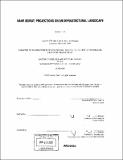Nahr Beirut : projections on an infrastructural landscape
Author(s)
Frem, Sandra
DownloadFull printable version (61.85Mb)
Other Contributors
Massachusetts Institute of Technology. Dept. of Architecture.
Advisor
Julian Beinart.
Terms of use
Metadata
Show full item recordAbstract
A century ago, Nahr Beirut was a riparian river which flowed from a mountainous valley to a coastal plain, the Beirut Peninsula, before entering the Julian Beinart Mediterranean Sea. After being for centuries the distant edge of Beirut, Nahr Title: Professor of Architecture Beirut today is the central spine of the Metropolitan Area, coinciding with a major transport corridor linking the coast with the hinterland. In 1968, the river was converted from a riparian river to a concrete canal and eventually, it mutated into an open sewer. The highway built on its right bank completed this conversion into an infrastructural conduit of sewage and transport. Informed by the notions of infrastructural landscape in Kathy Poole's article, Infrastructure in the ecological city, the thesis investigates Nahr Beirut through an urban and ecological analysis, and proposes measures for restoring the river, creating public space and enhancing the quality and management of water. In doing so, Nahr Beirut acts as a cultural catalyst which addresses citywide concerns of water supply, urban fragmentation and lack of public space. An overall plan addresses the ecological continuity of the river, flood mitigation, water management and treatment cycles. The plan proposes new navigational paths along the restored corridor, and sequences of public instances which respond to specific physical, infrastructural and urban conditions. Smaller scale proposals include public nodes and a series of land formation strategies that respond to the environmental and infrastructural situations. (cont.) Each strategy is manifested by formal manipulation leading to a new constructed ground (river + banks+ public space) which corresponds to the hydrological mutations of the river across the different seasons. Advancing that rivers as infrastructural landscapes can become urban, social and ecological structures which sustain amid political and aesthetic fluctuations, the thesis posits Nahr Beirut as a new cultural and ecological spine in the city, which mediates its infrastructural functions with its civic and environmental roles.
Description
Thesis (S.M.)--Massachusetts Institute of Technology, Dept. of Architecture, 2009. Vita. Includes bibliographical references (p. 195-199).
Date issued
2009Department
Massachusetts Institute of Technology. Department of ArchitecturePublisher
Massachusetts Institute of Technology
Keywords
Architecture.